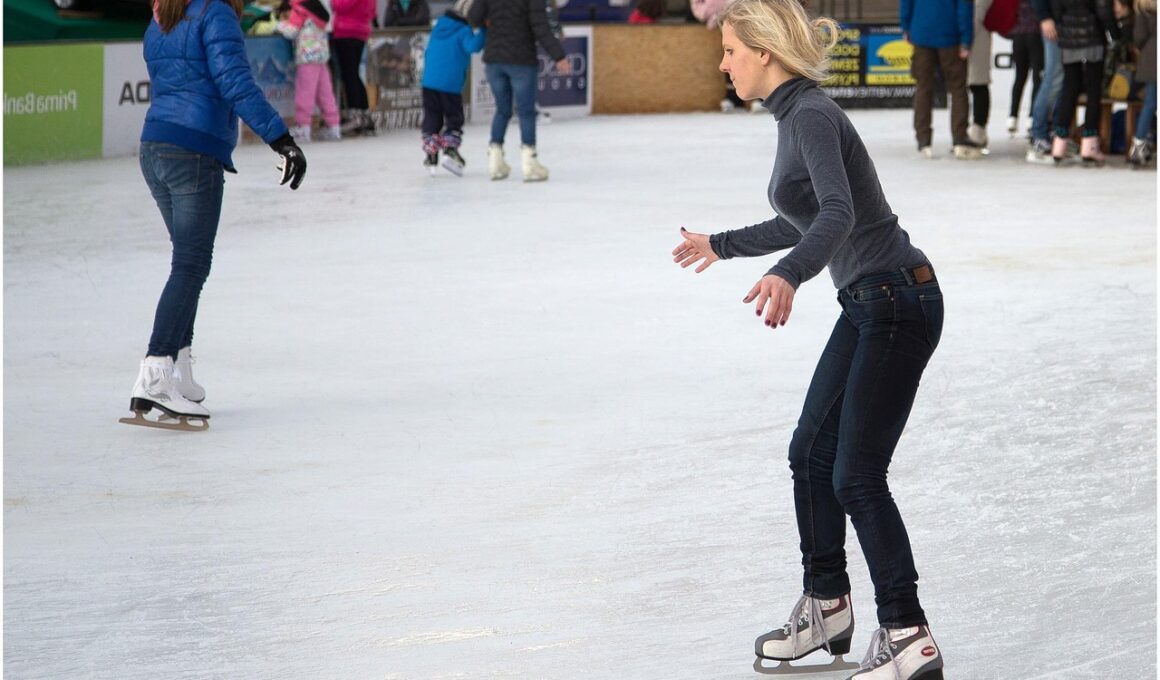Common Mistakes to Avoid When Starting Ice Skating
When embarking on your ice skating journey, it is essential to recognize common mistakes many beginners make. Firstly, avoiding proper warm-up exercises is one significant error. Just like any sport, warming up helps prepare your muscles and joints for the activity. Secondly, neglecting to wear appropriate gear, including well-fitted skates, is detrimental. Skates that are too tight or loose can cause discomfort and hinder your learning. Beginners should also avoid skating without taking lessons. While it might seem tempting to figure things out independently, the guidance from a qualified instructor can make a substantial difference in your progress. Furthermore, many beginners attempt to skate with an upright posture, which can lead to loss of balance. Instead, a slight forward lean is more beneficial for maintaining stability and control. It is also crucial not to rush the learning process, as each skill requires practice. Recognizing these mistakes will aid in smoother progression in ice skating. Practice reflects mastery, so take your time and enjoy the experience.
Another common mistake novices make is having unrealistic expectations regarding their skating skills. Many beginners expect to glide smoothly on the ice after just a few attempts. It’s vital to understand that ice skating requires time, patience, and practice to grasp the necessary skills such as balance and coordination. Accepting that falling is part of the learning process can prevent frustration. Secondly, beginners often stare at their feet while skating. This habit can lead to loss of balance and unexpected falls. Instead, try looking ahead to maintain better control of your trajectory on the ice. Additionally, beginners should not focus solely on speed. While it may feel exhilarating to skate quickly, it can lead to accidents if you haven’t mastered stopping techniques and balance first. Moreover, failing to practice stopping methods, such as the snowplow stop, can be dangerous and should be prioritized. Lastly, engaging in regular stretching and flexibility exercises outside of skating will enhance your performance. By learning to recognize these pitfalls, beginners can vastly improve their skating experience and enjoyment.
Improper Skating Techniques
A substantial mistake many beginners encounter is the improper use of edges while skating. Skating has two primary edges – the inside and outside edges of the blades. Beginners often over-rely on the outside edge, which can lead to slips and falls. Understanding how to utilize both edges appropriately will help skate more efficiently. Another frequent issue is using stiff legs during skating. Instead, maintaining a slight bend in your knees allows for better balance and control over your movements. This posture also helps absorb bumps and maintain a low center of gravity. Additionally, improper use of arms is another common mistake. Many beginners keep their arms awkwardly against their sides or flail them wildly, which can affect balance. Instead, keeping your arms out slightly helps maintain equilibrium and improves coordination. It is also crucial to avoid neglecting core engagement while skating; a strong core supports balance. Therefore, incorporating some core-strengthening exercises can significantly enhance your skating skills. By addressing these improper techniques, beginners can elevate their skills on the ice.
Another aspect that beginners often overlook is the importance of communication with instructors. Some novices assume that instructors will always know when they’re struggling with a technique. Initiating dialogue about challenges is essential for effective learning. It’s also crucial to understand that each skater has unique strengths and weaknesses, and what works for someone else may not work for you. Hence, don’t hesitate to ask for personalized feedback during lessons. Additionally, many beginners neglect the importance of practicing off-ice. While on-ice practice is critical, off-ice workouts focused on balance, stretching, and even strength training can enhance your skating ability. Exercises such as balance board training or yoga are helpful to build skills away from the rink. Furthermore, failing to observe advanced skaters can lead to missed learning opportunities. Watching experienced skaters can provide insights into techniques and strategies, helping inform your own practice. Goals should be set as they encourage progress; setting specific, measurable objectives keeps you motivated. Each practice session must advance skills gradually, preventing burnout while encouraging a lifelong passion for the sport.
Safety First
Safety should always be the top priority when learning ice skating. Beginners are often too excited to get out on the ice and end up overlooking essential safety checks. Wearing a helmet is critical, especially for those new to the sport. Head injuries can occur even at slow speeds, so protect yourself with proper gear. In addition, safety pads for wrists and knees offer extra protection against falls. Another mistake is skating in crowded areas without being aware of surroundings. It is essential to understand the rink’s layout and avoid areas where others may collide with you. Skaters should also be cautious about footwear off the ice; inappropriate shoes can lead to slips. When transitioning from off-ice to on-ice training, take your time to adjust and don’t assume that your balance is the same. Properly learning how to fall safely can minimize injuries; falling forward instead of backward will help you get back up quickly. Ultimately, emphasizing safety during your practice makes your ice skating experience enjoyable and rewarding.
Consistency is equally crucial in ice skating. Many beginners practice sporadically, missing out on the benefits of regular sessions. Committing to a structured practice schedule can accelerate improvement and solidify new skills learned during lessons. Additionally, overreliance on support aids such as the wall or skate aids can hamper progress. It is vital to develop confidence and balance without dependency on external objects. Moreover, many novices forget to focus on their footwork. Skilled skating requires fluid foot placement, and beginners should practice gliding and stopping techniques repeatedly. Another common mistake is rushing through each practice session, trying to accomplish too much too quickly. Take the time to master fundamental skills before moving on to more advanced techniques. Learning to enjoy the process rather than just aiming for results will encourage a positive mindset while skating. Documenting your progress, whether through videos or journaling, can help identify areas requiring improvement. In conclusion, consistent effort and mindful practice are the keystones to a successful ice skating journey.
Conclusion and Encouragement
In conclusion, avoiding common mistakes can dramatically enhance the ice skating experience for beginners. Awareness of these pitfalls, such as improper techniques and neglecting safety, will pave the way for more successful and enjoyable skating. Skaters should always keep an open mind, embracing feedback and utilizing resources to learn effectively. The journey of ice skating is not just about mastering techniques; it’s also about building confidence and resilience. Remember that everyone progresses at their own pace; celebrate each milestone, no matter how small. The thrill of gliding effortlessly across the ice is achievable with time and practice. Friends and family can play a vital role by providing encouragement and sharing experiences on the ice, making the journey more fulfilling. Additionally, consider joining a local skating club to connect with others who share the same passion. Engaging with a community can inspire growth, accountability, and lasting friendships. So lace up your skates, embrace the learning process, and enjoy every thrilling moment on the ice.
This is another paragraph with exactly 190 words…


